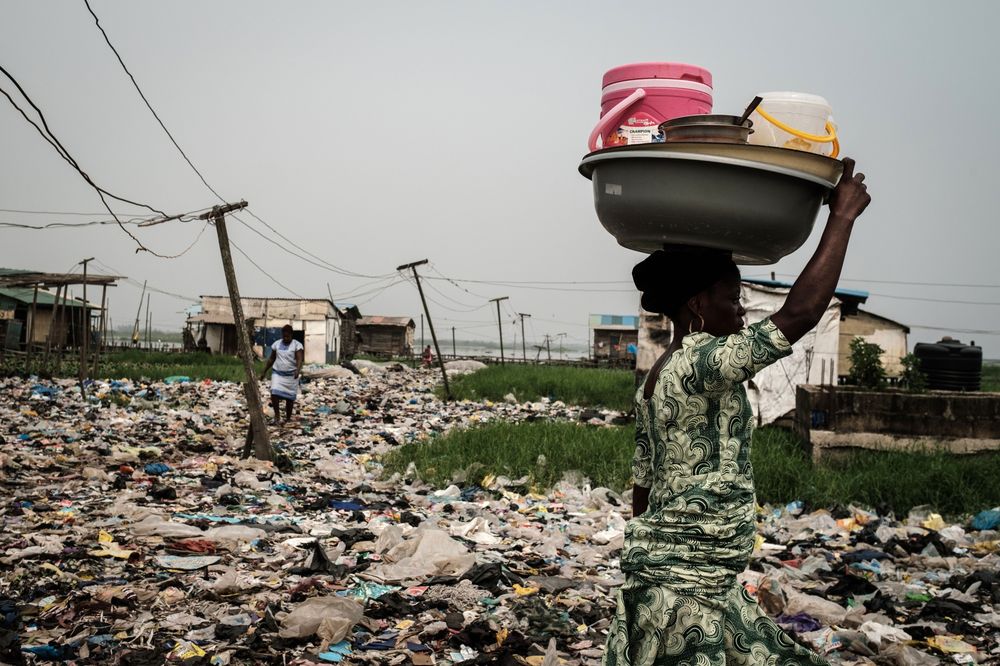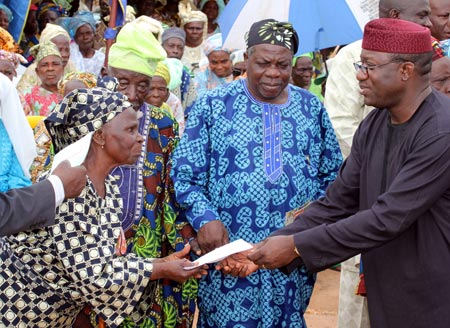General
12 million Nigerians Became Poor in 10 Years—UNDP

By Adedapo Adesanya
The 2019 Global Multidimensional Poverty Index (MPI) Report has revealed that the number of “multi-dimensionally poor” Nigerians increased by 12 million from 86 million to 98 million between 2007 and 2017.
The report, released in New York on Thursday by the United Nations Development Programme (UNDP) and the Oxford Poverty and Human Development Initiative, noted that the proportion of people who “are multi-dimensionally poor” had remained constant at just over 50 percent over the past decade up to 2017.
Multidimensional poverty includes the various deprivations experienced people in their daily lives – such as poor health, lack of education, inadequate living standards, disempowerment, poor quality of work, the threat of violence, and living in areas that are environmentally hazardous, among other indicators.
It explained that the global MPI highlighted inequalities at the global, regional, national, sub-national and even household level.
The study further revealed that the poorest countries exhibited not just higher incidence of multidimensional poverty, but also higher intensity, with each poor person deprived in more indicators.
This year’s MPI report presented that more than two-thirds of the multi-dimensionally poor – 886 million people – live in middle-income countries, while a further 440 million live in low-income countries.
In both groups, figures show simple national averages can hide enormous inequality in patterns of poverty within countries.
In Nigeria’s case, the report showed that even though the national average showed that around 50 per cent of Nigerians were multi-dimensionally poor, state and local government levels would reveal a completely different scenario.
It stated, “In Nigeria, even though the proportion of people who are multi-dimensionally poor has remained constant at just over 50 per cent over the past decade (up to 2017), the actual number of people who are multi-dimensionally poor increased from 86 million to 98 million over the same period.
“Also, important to note is that when compared to the national poverty line which measures income/consumption, a larger proportion of Nigerians (51 per cent) are multi-dimensionally poor than those that are income poor (46 per cent).”
The MPI, according to the UNDP, is the product of the incidence and the intensity of multidimensional poverty, and both are important aspects, noting that any reduction in intensity reduces MPI even if incidence remains unchanged and reflects progress towards moving people out of poverty.
General
KWAM 1 Ends Awujale Ambition, Withdraws Legal Challenge

By Adedapo Adesanya
Fuji musician, Mr Wasiu Ayinde, popularly known as K1 De Ultimate or KWAM 1, has formally withdrawn from the race for the Awujale of Ijebuland after staunch opposition to his ambitions.
This came as the minstrel filed a notice of discontinuation at the Ogun State High Court to end his legal challenge against the ongoing selection process.
The notice, filed on Monday, December 22, 2025, by his legal team led by Mr Wahab Shittu (SAN), brings to a close his controversial bid for the revered throne.
The withdrawal followed a ruling by Justice A. A. Omoniyi of High Court 3, Ijebu-Ode Judicial Division, who dismissed KWAM 1’s application for an interim injunction seeking to restrain the Ogun State Governor, Mr Dapo Abiodun, the Fusengbuwa Ruling House and other parties from proceeding with the selection of a new Awujale.
Justice Omoniyi held that the application lacked merit but ruled that the substantive suit could proceed on its merits, fixing January 14, 2026, for further hearing.
KWAM 1, the Olori Omooba of Ijebuland from the Fidipote Ruling House, had approached the court after the Fusengbuwa Ruling House declared him ineligible to contest for the stool, insisting he was not a bona fide member of the ruling house and therefore could not vie for the throne under its platform.
However, with the filing of the notice of discontinuation, KWAM 1 appears to have formally recused himself from the Awujale selection process, effectively ending his challenge.
He joined as respondents in the case: the Ogun State Governor, the Commissioner for Local Government and Chieftaincy Affairs, the Attorney General and Commissioner for Justice, the Secretary of Ijebu-Ode Local Government, the Chairman of the Awujale Interregnum Administrative Council, and the Chairman of the Fusengbuwa Ruling House.
In the application, KWAM 1 contended that he is a bonafide member of both the Fusengbuwa and Fidipote ruling houses, and that his rights as a potential candidate were being threatened by what he described as a flawed and unlawful process.
He alleged that the Awujale Interregnum Administrative Council, which he described as an “unrecognised body”, was exerting influence over the nomination procedure in violation of Ogun State chieftaincy laws.
Central to his claim was the argument that due process was not followed, particularly the requirement that the Ijebu-Ode Local Government formally publish the names of the 13 recognised kingmakers before any selection exercise commences.
KWAM 1 maintained that the failure to comply with this step rendered the process vulnerable to legal challenge.
The suit was filed against the backdrop of the vacancy created by the death of Oba Sikiru Kayode Adetona in July, at the age of 91, after a reign of more than six decades.
General
Dangote Unveils Phone Number to Report MRS Stations Selling PMS Above N739

By Modupe Gbadeyanka
A hotline number, 0800 123 5264, for Nigerians to report any MRS Oil Nigeria Plc filling stations selling Premium Motor Spirit (PMS), commonly known as petrol, above the approved pump price of N739 per litre, has been released by Dangote Petroleum Refinery.
The private refiner said the number was now active nationwide, enabling consumers to promptly report violations and help maintain fair pricing across over 2,000 MRS stations.
This measure follows the refinery’s recent commencement of nationwide PMS sales at N739 per litre—a strategic intervention aimed at stabilising fuel prices and easing the financial burden on Nigerians during the festive season.
“We encourage Nigerians to avoid purchasing PMS at inflated prices when locally refined fuel is available at N739 per litre.
“Report any MRS station selling above this price by calling our hotline. Together, we can ensure that the benefits of this price reduction reach every consumer,” the company stated in a statement.
The organisation stressed its mission to deliver affordable, high-quality fuel while safeguarding national economic interests, reaffirming its commitment to steady supply, backed by a guaranteed daily output of 50 million litres, and warned against attempts to create artificial scarcity or manipulate supply.
Regulatory authorities have been urged to remain vigilant and take decisive action against unpatriotic practices.
By refining locally at scale, Dangote Refinery is reducing Nigeria’s dependence on imports, conserving foreign exchange, stabilising the Naira, and strengthening energy security. This initiative represents a significant milestone in the country’s journey toward sustainable energy solutions and economic recovery.
The refinery also issued a stern warning against attempts by unscrupulous operators to create artificial scarcity in response to the price reduction, calling on government agencies to act decisively.
“Any attempt to create artificial scarcity or manipulate supply to frustrate recent price reductions is unpatriotic and unacceptable. We urge regulatory authorities to remain vigilant and take firm action against such practices, especially during this critical festive period,” the statement added.
Consumers were advised to resist purchasing fuel at inflated prices when cheaper, high-quality alternatives are readily available.
General
ANLCA Airport Chapter Scores Salamatu High on Stakeholder Engagement, Trade Facilitation

By Bon Peters
The Airport Chapter of the Association of Nigerian Licensed Customs Agents (ANLCA) at Omagwa Rivers State has praised the Customs Area Controller for Customs Area 1 Command, Comptroller Salamatu Atuluku.
At the end-of-the-year party attended by stakeholders, including the leader of the association’s chapter, Mr Charles Onyema, said the customs officer has done well in stakeholder engagement and trade facilitation.
At the event held last Friday, he said his association has been enjoying a very cordial relationship with other organisation in the ecosystem.
“You can see what is happening today, everybody is working together and our operations here are seamless,” he noted.
He stated that apart from creating a very robust business environment for his members and other stakeholders to operate, he has taken a decision to build and commission a befitting ANLCA Secretariat which would be completed soon and be commissioned by the ANLCA national president, Mr Emenike Nwokeoji.
The ANLCA chapter chief said since “Comptroller Salamatu Atuluku assumed office at Customs Area 1, Port Harcourt Command, it has been a different ball game, facilitating trade and increasing Revenue generation.”
“I remember I told her she was a mother during her maiden visit to the airport.
“You know when you have a woman in charge of an affair, food will not lack, compassion will not lack and motherly love will not lack.
“She is very wonderful in stakeholder engagement, revenue generation and trade facilitation,” Mr Onyema enthused.
Projecting into the future, Mr. Onyema said the year 2026 would be better for his members, adding that he has advised them on financial discipline which he said would help them during the trying period.
-

 Feature/OPED6 years ago
Feature/OPED6 years agoDavos was Different this year
-
Travel/Tourism9 years ago
Lagos Seals Western Lodge Hotel In Ikorodu
-

 Showbiz3 years ago
Showbiz3 years agoEstranged Lover Releases Videos of Empress Njamah Bathing
-

 Banking8 years ago
Banking8 years agoSort Codes of GTBank Branches in Nigeria
-

 Economy3 years ago
Economy3 years agoSubsidy Removal: CNG at N130 Per Litre Cheaper Than Petrol—IPMAN
-

 Banking3 years ago
Banking3 years agoFirst Bank Announces Planned Downtime
-

 Banking3 years ago
Banking3 years agoSort Codes of UBA Branches in Nigeria
-

 Sports3 years ago
Sports3 years agoHighest Paid Nigerian Footballer – How Much Do Nigerian Footballers Earn












